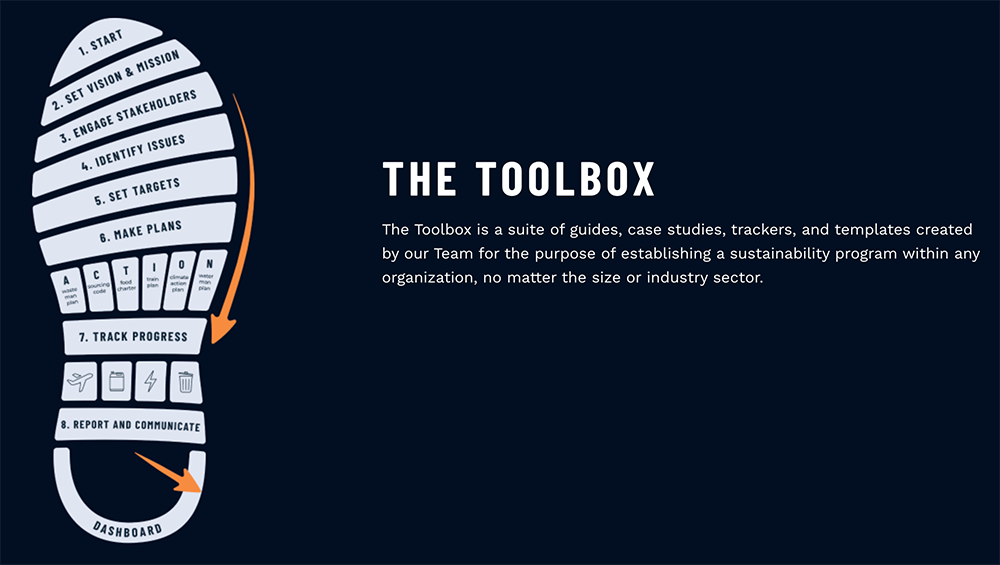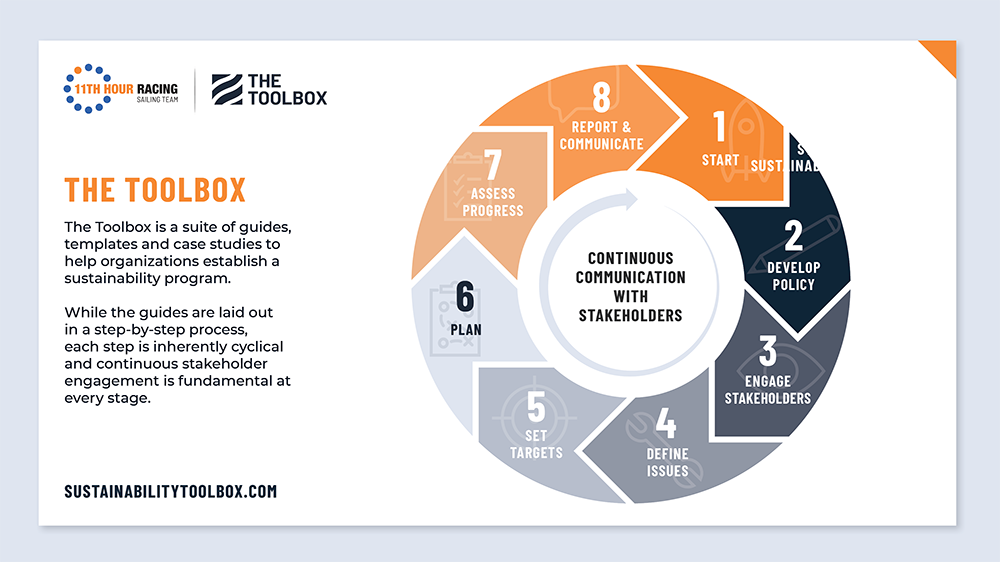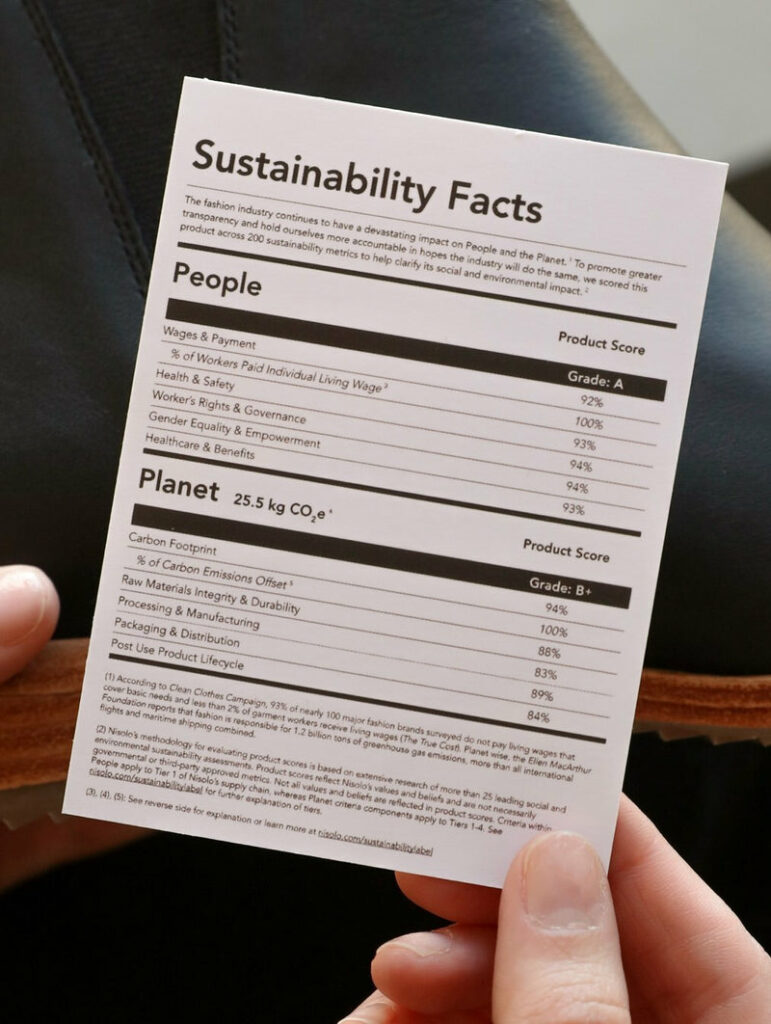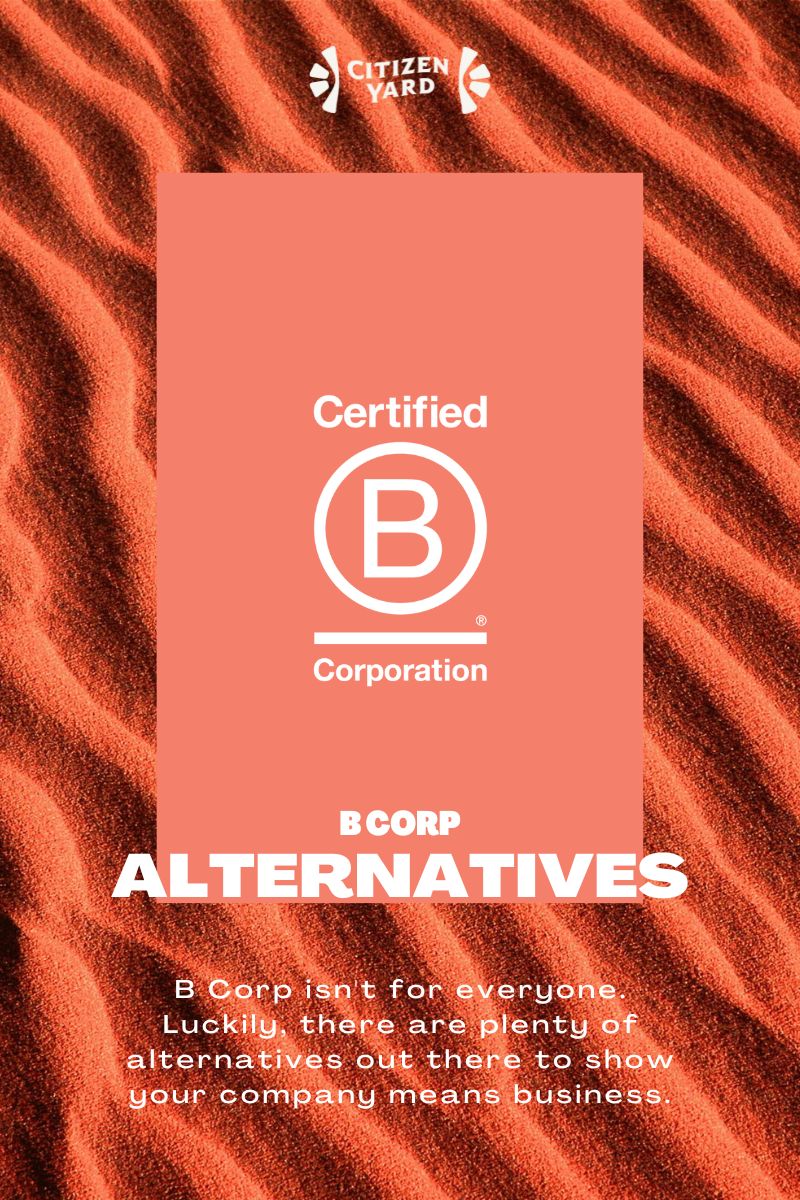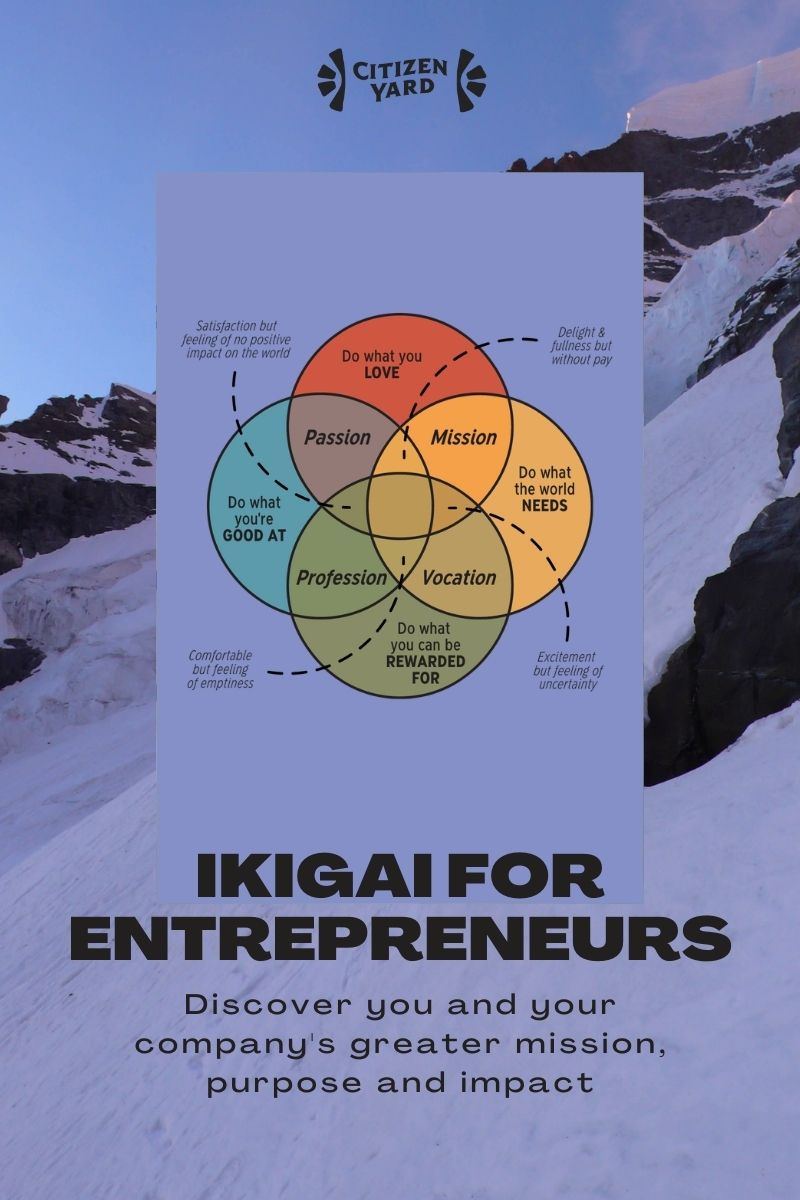
B Corp Month — The Good Business Case Files
Table of Contents
March is B Corp month.
Bet you didn’t know there was a whole month committed to the cause but now you do 😉
Citizen Yard is joining B Lab and the B Corp community all month long to go #BehindTheB and share the ins-and-outs of how Certified B Corps are doing business a little differently.

This month we’re throwing the doors open on B Corps to highlight what makes them tick. While its become increasingly common for people to distrust companies, B Corps offer a more transparent way of doing business as usual.
New to B Corp and wondering what it even is? Read our article “What Is a B Corp?” first.
Let’s quickly review the basics.
The mission behind B Corp is to transform the global economy into one that considers its impact on profits, people, communities and the planet a bit more equally.
While we can thank capitalism for its many gifts in the form of groundbreaking technologies, medical advancements, global communications and improved standards of living, we can also thank it for inequality, monopolies, worker exploitation, depletion of natural resources and advancing the climate crisis.
And we’ve all just accepted this as the price of progress.
What B Corp strives for is an economy that keeps the progressive benefits of capitalism while attempting to eliminate its more repressive qualities. Sounds like a pipedream, but every day more and more businesses are subscribing to the stakeholder model of governance upheld by B Corp.
Which is why we’re pulling back the curtain to reveal some of the unique ways companies are embracing these ideals to launch social, environmental and economic revolutions.
Companies that certify as B Corps are required to take all stakeholders into account when making business decisions. Performance is measured in five key impact areas:
- Governance
- Workers
- Environment
- Community
- Customers
Companies certified as B Corps must achieve a third-party verified baseline level of stewardship and transparency in each of these areas to maintain certification.
Today we thought we would show you how other companies are thinking beyond the minimum standard of ESG stewardship and innovating unique practices in their organization. We’re shining the spotlight on six companies, breaking down their impact model, then giving you a takeaway to incorporate in your own business infrastructure.
***
• Governance •
Emboo River Camp’s
stakeholder-centric closed loop system
Stakeholder governance and considering one’s impact on all stakeholders — workers, environment, community and customers — forms the core of B Corp.
In an ideal world, a company’s actions would have zero harmful effects on all its stakeholders and create nothing but beneficial problem solving for all. But we live in the real world, not Shangri La, and every single company produces some sort of harmful impact. For B Corps, the goal is to minimize harm as much as possible and neutralize the rest.
One way to minimize impact is to create a closed loop system.
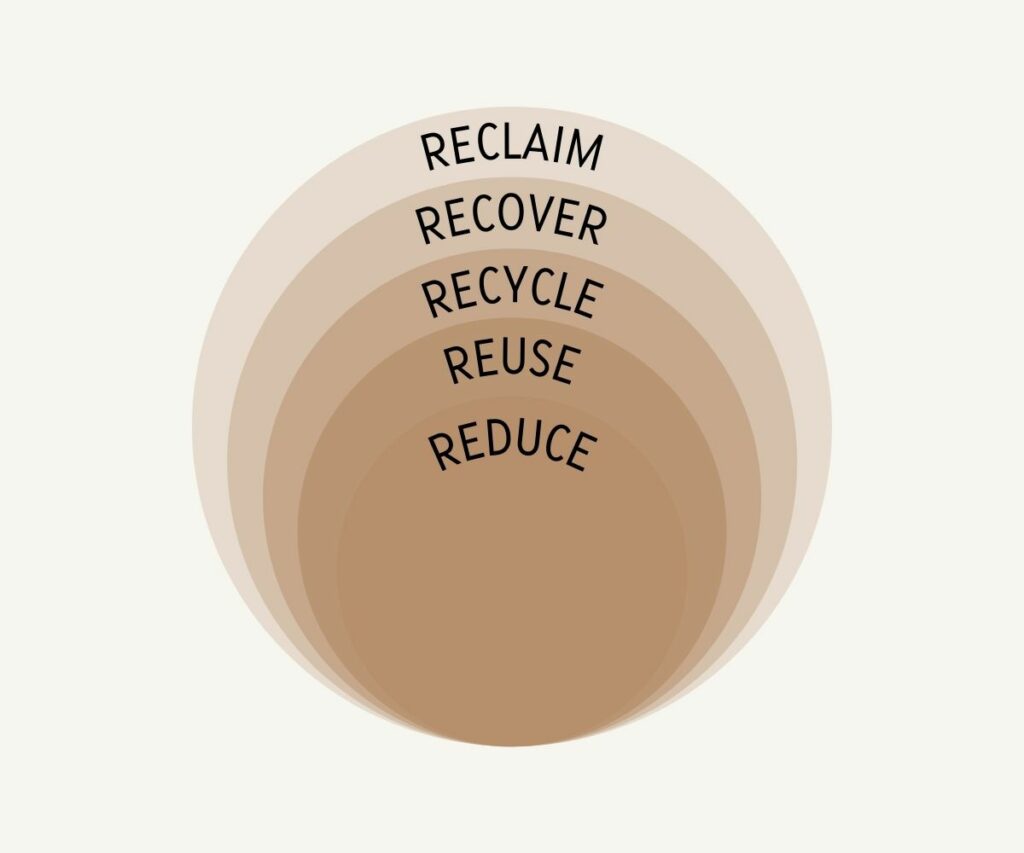
In a closed loop system — also known as a circular economy — businesses reuse materials, repurpose waste and recycle the goods used in its supply chain.
A perfect closed loop system is rare if not debatably impossible, but the fine people at Emboo River Camp are just about as close to perfect as you can get.
Emboo River Camp is the first and only full luxury eco-lodge in the Maasai Mara. From using carbon neutral, electric vehicles for safari drives to instilling indigenous Maasai at the head of team leadership, there isn’t a stone left unturned in Emboo’s governance operations.
Emboo’s story began in 2018, when founders Loïc Amadò, William Santian and Valery Super vented their frustrations regarding the safari industry’s status quo. The safari industry tends to tout a message of connecting with nature and experiencing wildlife but ironically pollute the local ecosystem in the process.
They knew there had to be a way to go on a safari without leaving a trace.
Using innovation, technology, strategic partnerships and a team of passionate people, the team developed a unique closed loop system that revolves around local elements, the local community and renewable resources.
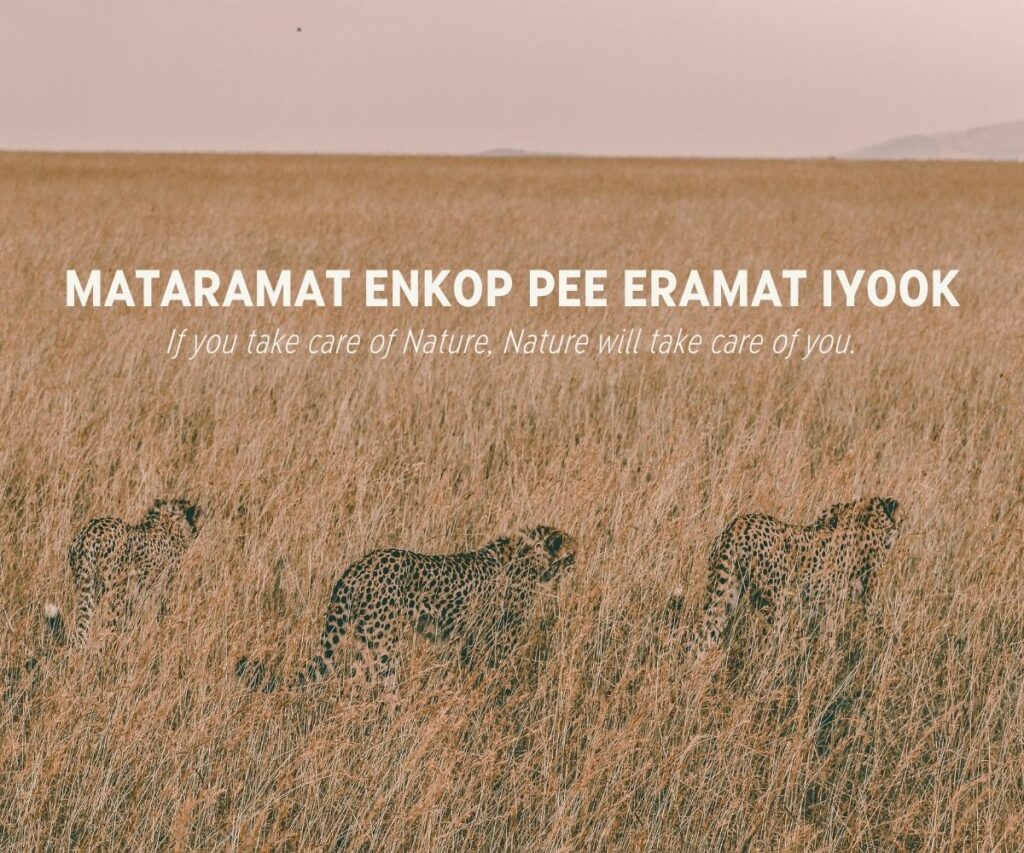
One of the keys to Emboo River’s success is its willingness to work with the natural Maasai Mari environment — not fight it. Rather than use external operations such as water trucks, generators and fuel vehicles, they’ve established a holistic approach that taps into nature and utilizes a hybrid of modern and traditional technologies for a gentle extraction, use and recycling of resources.
Emboo’s closed loop approach hones in on six areas of stakeholder engagement:
- Water management
- Renewable energy
- Mobility
- Nutrition
- Clean environment
- Community engagement
Not only has Emboo developed an exceptionally well-thought out form of governance, but they do it while still delivering an impeccably luxurious experience for their guests. You don’t have to scroll far through their website to get lost in a wanderlust daydream.
All images owned by Emboo River Camp and are used here for showcase purposes only
With such a complex closed loop system one would think it would result in a costly solution. But in fact, Emboo saves thousands of dollars every year in operational costs directly attributable to closing the loop.
Collecting and recycling rain water means they aren’t paying for water to be brought in. Converting organic waste matter into biogas for cooking eliminates generator costs. And to top it all off, electric vehicles mean no combustion engine. Which means no noise and no gas to alarm animals letting drives not only find wildlife more frequently but get closer as well.
You can read Emboo River’s Case Study in full under the ‘Vision Report’ on their Innovation Hub.
Your turn to put governance in action
If you’ve hung out with Citizen Yard for any amount of time now, you know we firmly believe in taking your company’s impact journey one step at a time.
Creating a closed loop system is a very lofty and difficult undertaking, but don’t let that discourage you from taking it on!
To begin closing the loop in your business, make a list of all the stakeholders your company impacts and list them by impact area.
We’ll be using an imaginary business, Pure Spa, as an example.
Pure Spa is going to list out all its stakeholders and categorize them under either community, environment, workers or customers.
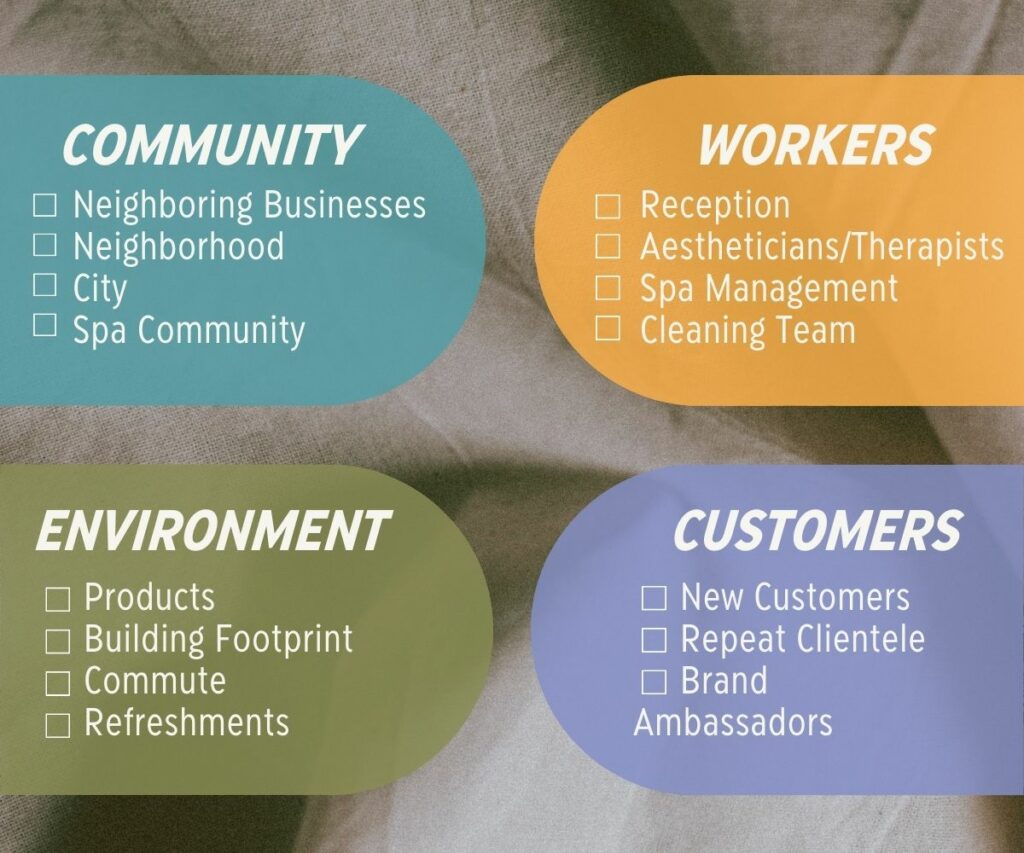
Now out of this list, Pure Spa selects a single stakeholder to focus on.
Think of this as a starting point. Brainstorm every possible way your company impacts this stakeholder.
In Pure Spa’s case, we’re going to focus on ‘products’ under the Environment impact pillar.
As a spa, we’re going to think about what products we’re using in our treatments. On a scale of 1-10, how sustainable are they? Be honest. If they aren’t sustainable at all, is there a better option? If they are sustainable, can we maybe perhaps optimize even more and find something similar made by a company in our local community?
We find mind mapping to be helpful with this exercise. Go down a rabbit hole of asking questions around the stakeholder and thinking of solutions. Dream big! When you’re done, repeat the same exercise with another stakeholder.
Remember, you don’t have to be perfect and develop a holistic closed solution at the start. Just get the ideas out in the open and uncover loops to close along the way.
***
• WORKERS •
Two Octobers' Apprenticeships Program
Trains Tomorrow's Leaders
Empower the people that power your company: that’s the unofficial B Corp workers motto.
B Corps make a point to keep their workers happy, healthy and thriving. And they’re willing to incentivize workers beyond the standard minimum-wage to keep them that way.
A few quick facts about B Corps when it comes to their workers:
- 84% of B Corps allow for flex time working schedules (20% more than ordinary businesses)
- B Corps are 71% more likely to offer paid time off for community service in comparison to ordinary businesses
- B Corps are 94% more likely to offer part-time employees healthcare in comparison to ordinary businesses
The bar doesn’t start with current workers either, but with potential workers as well. B Corps are more likely to invest in training programs for workers and use procedures that hire from diverse and marginalized communities to support a more diverse workforce.
Just take a look at Two Octobers.
Two Octobers is a digital marketing agency and Certified B Corp out of Denver, Colorado. In 2020, Two Octobers launched an apprenticeship program to on-ramp Black, Indigenous and other People of Color sans college degree into the world of digital marketing.
“College is not an option or a fit for a lot of people. Requiring experience and a degree for entry-level jobs is not only unjust, it is bad for our business. The best teams I have been a part of weren’t built on credentials, they succeeded based on passion and diverse perspectives.”
— Nico Brooks, Founder at Two Octobers
In April 2020, during the pandemic, Two Octobers received PPP funding for small businesses. Since the whole purpose of the PPP loan was to keep communities alive during lockdown, they discussed how they could use the loan to reinvest it into their apprenticeship program to keep locals employed.
Naturally, a little bureaucracy was involved and they reached out to the Colorado Department of Labor to register the program and serve as guidance through the process. Two Octobers was required to blueprint the program, outlining the training the apprentice was to receive and establish metrics for performance.
To market the program to the right applicants, they worked with local workforce agencies who are well connected to vocational programs, job fairs and other channels, including workers with incarceration records and those finishing military service. The result: they were able to reach communities outside the usual LinkedIn and ZipRecruiter gutter.

“We all know people — and maybe are those people ourselves — who did not thrive in college but thrive in the workplace. College is not a great predictor of success at work.” Nico Brooks
Two Octobers knew the apprenticeship program would need a hands-on training-style approach. They dedicated a team member to serve as a primary mentor for apprentices to guide them into their role. To help keep things from getting overwhelming, apprentices start on a part-time basis while they get their feet wet in the agency.
The apprenticeship isn’t treated like you would find in some corporate offices where interns are glorified coffee fetchers. Apprentices at Two Octobers undergo on-the-job training working with mentors on tasks before working on them alone.
A key component to the program was setting expectations and company culture from the start during the hiring process. They looked for enthusiasm, curiosity and an eagerness to learn over credentials. Additionally, they removed bias from the process by removing identification information and screening prior to review.
The apprenticeship program has been so successful for Two Octobers that they’ve replaced entry-level hiring in lieu of apprenticeships moving forward and have even set aside a budget to train apprentices for other B Corps.
Your turn to make an impact on your workers
Not all companies are in a position to hire, so we’re going to start making an impact among our workers by looking within and establishing internal promotion programs.
The standard hiring cycle is just as exhausting for your workers as it is for you. No one enjoys going through the uncertainty that comes with the job hunt. Unengaged workers don’t want to leave your company, but they don’t want to stay in their current position either. According to studies, the majority of workers actually just want more responsibility, recognition and involvement in their current roles. They want to know that the work they do matters and that they’re a valued part of it being done. In short, they want to know they’re valued as more than just a cog in the machine.
A solution? Promote from within.
Promoting from within starts with company culture. Establish a company culture where promotions are a right, not a reward.
Formalize the internal hiring process and explicitly write out internal mobility policies. Workers need to know they’re in a safe place with a developed path for career growth.
Let’s look at how our example business Pure Spa handles this.
1. The Company Handbook
Every worker at Pure Spa is given an Employee Handbook on their first day of work. The Employee Handbook outlines all important company policies & procedures including internal mobility. The owner of Pure Spa or a manager verbally explains to new hires how one can grow with the company and encourages them to take advantage of their training library.
→ Your Takeaway: Engrain internal hiring in your company culture and outline mobility policies in the Employee Handbook.
2. Mentoring & Enrichment Opportunities
Pure Spa has developed a Training Library of internal resources all workers can utilize for career development. For Pure Spa this includes everything from career wellness trainings to resume and interview reviews. Seasoned workers are encouraged to mentor new employees in their craft and help them grow.
→ Your Takeaway: Begin to build a library of resources that encourages workers in their career development.
3. Post Positions Internally
When new roles need filling at Pure Spa, positions are communicated internally first. Workers are given a 2 week period to submit applications for review. Typically, an internal hire is selected before even needing to look externally and often the worker moved up ends up mentoring the new hire who fills their old position.
→ Your Takeaway: Give workers first dibs on open positions before searching outside your organization.
4. Set Performance Metrics
Pure Spa realizes that not all internal hires are a fit for just any position that opens up. Which is why they conduct regular employee reviews. During reviews they sit down with workers to let them know how they’re doing. During this time they communicate the qualities they value in workers and those required for more senior positions (ie. collaboration, initiative, team advocacy) along with quantitative attributes (ie. good attendance record, exceeding quotas).
→ Your Takeaway: Set the bar for workers by communicating standards of performance.
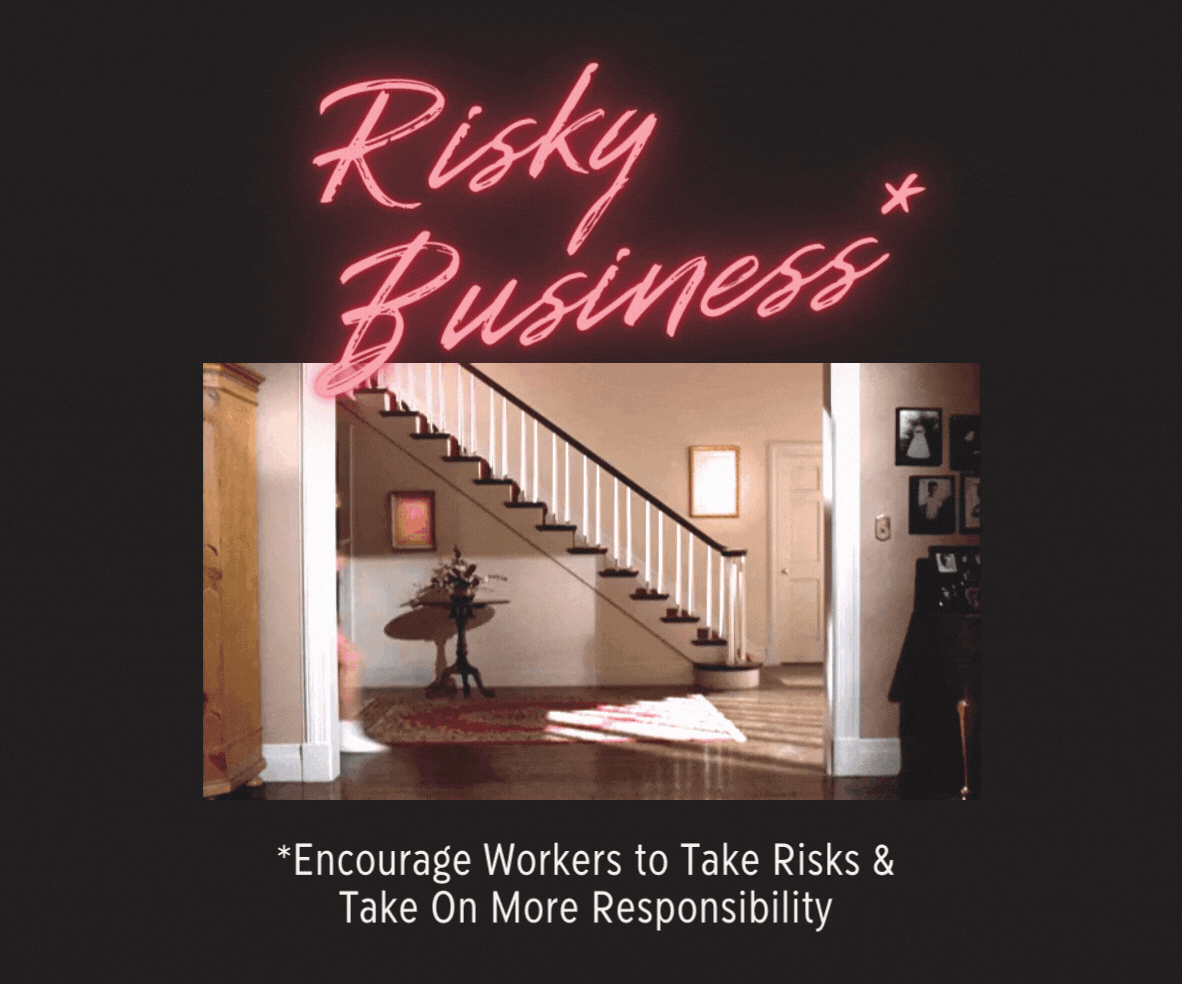
5. Encourage Workers To Take Risks & Take On More Responsibility
Pure Spa encourages workers to take on more risk and responsibility in their positions. They know that the best way to judge whether or not someone is ready for a promotion is to have them handle new situations. How do they handle new tasks and the pressures that come with it? The key here is to let them take the risk but give them grace to fail.
→ Your Takeaway: Provide a safe space for workers to try new things and build on their current responsibilities. If they get back up and learn from failure, you have a keeper.
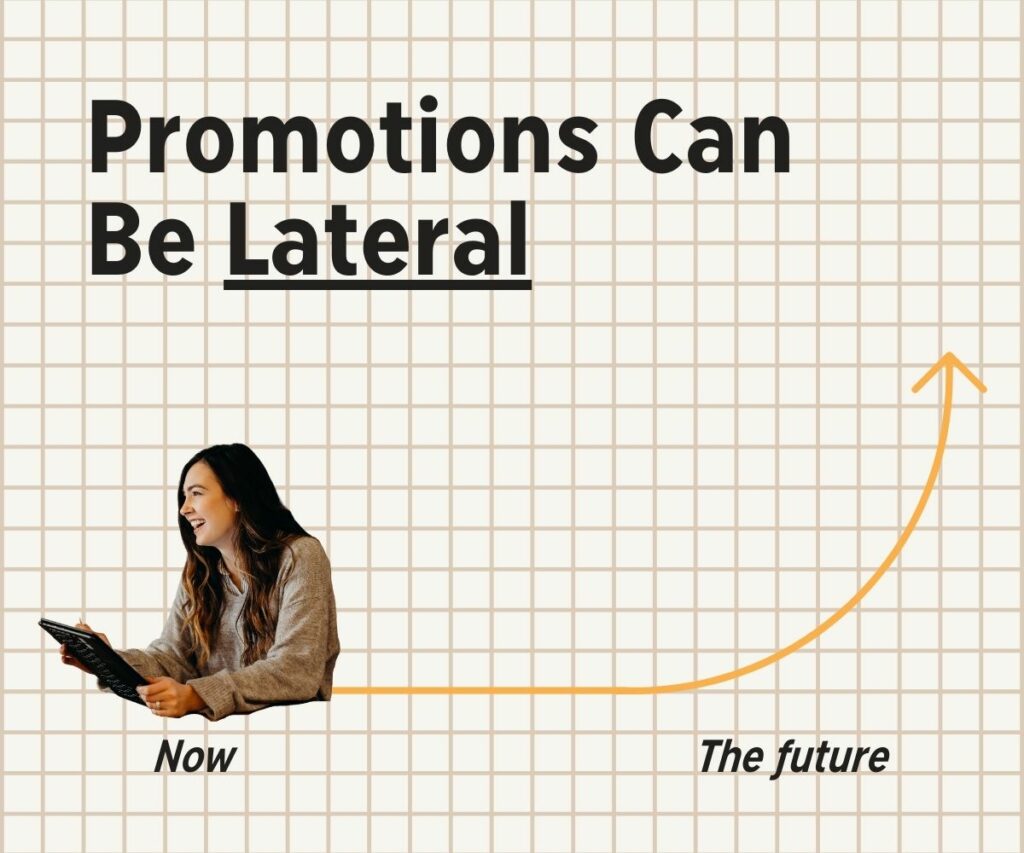
6. Promotions Can Be Lateral
Internal mobility isn’t always vertical; it can also be lateral. Pure Spa has had workers who need a refresh in position but weren’t quite ready to move up, so they allow workers the opportunity to try something new. Not only does this refresh a seasoned worker but oftentimes leads to learning the skills they need to move up in the future.
→ Your Takeaway: Allow disengaged workers to try a new position and do something new.
***
• ENVIRONMENT •
11th Hour Racing Team creates an
eco measurement tool for the masses
Every company has some sort of impact on the environment.
Even digitally-based companies have an environmental footprint. Did you know the average website produces 4,500 pounds of CO2 a year?
Environmental statistics has organizations of all kinds wondering about their environmental impact. Questions like, “Do we have a plan in place to reduce emissions? And in instances where reduction isn’t yet possible, is there a way we can offset?”
You’re not alone if you don’t know where to begin.
Enter the 11th Hour Racing Team.
11th Hour Racing Team is a high-performance ocean racing team, sailing around the world with a focus on sustainability at the helm. Though not yet a B Corp (they’re working on it) 11th Hour’s mission is to, “accelerate change through sporting excellence in sailing, ocean advocacy, and sustainable innovation.”
There’s a lot these guys are doing right.
As a sailing team, they race around the globe in some of the world’s most prestigious yacht races, while leaving positive impact for ocean health in their wake.
Their impact starts with a transparent set of sustainability goals prominently displayed on their website. Following targets set by the United Nations Sustainable Development Goals, 11th Hour breaks down the programs they have in place to measure their impact on the environment. Additionally, they directly report the year’s activities, goals, measurements and achievements in an annual sustainability report.
But these guys took it a step further to help other businesses do the same.
11th Hour Racing Team created The Toolbox: A suite of guides, tools and templates to help other organizations create their own sustainability program.
11th Hour went above and beyond in creating The Toolbox. It’s free for any organization to use and is customizable for companies of any size and sector.
Your Turn to take environmental action
11th Hour made it easy for you to take environmental action: download The Toolbox and begin tracking your environmental footprint.
The Toolbox is broken down into eight stages:
- How to Start Your Sustainability Program
- How to Create a Sustainability Policy
- How to Engage Stakeholders
- How to Identify Issues
- How to Set Targets
- How to Implement
- How to Assess Progress
- How to Report & Communicate
The Toolbox is comprehensive in its methodology. It walks organizations through the process from the bare basics of starting a sustainability program all the way through establishing a communications plan that relays your company’s impact to stakeholders.
What we like best about The Toolbox is its granular approach. Each of the eight stages is broken down in detail. You’ll find:
- HOW-TO GUIDES: Each how-to guide gives a step-by-step breakdown of the stage to explain the process and how to implement
- TEMPLATES: There are 24 customizable templates throughout The Toolbox to draft up a policy, map stakeholders, track targets and more
- CASE STUDIES: Each stage includes a comprehensive case study to show the stage and its templates in use in a real world setting
***
• COMMUNITY •
How 4Ocean & Bureo turn
ocean plastics into treasure
B Corps make it a point to be active members in their communities.
Community impact encompasses:
- The physical location of an organization
- The partners that make up its supply chain
- And in this digital world, it can even mean the digital communities it interacts with
In this good business case study on community, we’re actually going to take a look at two companies this time: 4Ocean and Bureo.
4Ocean and Bureo are two companies with a lot in common. They’re founded by surfers, they’re both B Corps and a core function of their operations is to pull plastic pollution from the ocean. Where they differ, is in how they engage their respective communities in their crusade against ocean plastics.
Let’s look at 4Ocean first.
4Ocean is a global team of ocean evangelists dedicated to cleaning up our waterways. They take the plastics collected from ocean and beach clean ups, recycle it and turn it into their flagship bracelets with each bracelet supporting global ocean conservation efforts.
4Ocean’s community approach is mostly focused on engaging the everyday person. For starters, clean up efforts remove pollution and beautify the local communities in which they operate. But they also employ directly from local communities to lead operations. Captains, crew and artisans are sourced from it’s facilities which include:
- 1 global headquarters
- 6 operational bases
- 1 global fulfillment center
- 3 storage warehouses
- 1 plastic lumber facility
These numbers amount to 250+ full-time employees; 350+ bracelet artisans.
4Ocean realizes pulling plastic isn’t a one-size fits all approach. Each community has a custom approach in how it operates. From the overall clean up strategy and tools used at recycling facilities, to local community education outreach, each location receives its own strategy.
Many of 4Ocean’s captains and crew come from the fishing industry. This isn’t an accident but a purposeful choice to flip expertise and encourage local community-wide ownership. Overfishing in delicate ecosystems 4Ocean impacts, such as Bali, is common. But 4Ocean captains now use their lifelong fishing expertise to source ocean plastics instead of fish.
Bureo takes a different approach to community impact. Bureo is a company more focused on engaging the community from a business supply chain angle.
Bureo is also focused on pulling plastics from the ocean, namely in the form of plastic fishing nets. They then breakdown the plastic into pellets that are repurposed to create everything from hat brims and surf fins to skateboards. As for the community, their twist is one that engages more with strategic partners along its supply chain.
To date, local fishermen in South America didn’t have many end-of-life solutions for their nets. Bureo takes those nets for recycling and works with members of the community to pull fishing nets from oceans. Once nets are pulled, they are recycled and turned into NetPlus material. Bureo then works with other companies — Costa, Patagonia, Trek and even Jenga are all partners — to use NetPlus as an alternative to plastics in their products.
Their business models is one that impacts communities all along its supply chain. From training and incentivizing local fishermen in more sustainable practices to providing a quality plastic alternative to other organizations, they close a crucial supply chain loop.
Your turn to take action in your community
Every business can take community action, you simply have to leave the office and engage.
A great starting point is to incorporate a company volunteer day.
Need help coming up with ideas for volunteer day? Try something related to your business. Is there a volunteer opportunity that’s a natural fit for your company?
In the case of Pure Spa, they’re an organization focused on wellness. For company volunteer day, they’ve joined forces with a mental health provider to put together a community wellness fair.
When setting up a team volunteer day, treat it like a holiday. Suspend normal business hours and have your entire team volunteer for the mission together. This not only gets your business out there in the community but bonds your team over a common cause which makes for great camaraderie.
Remember, this is a day to mix up the normal work grind and spend time in the community. Take pictures, post about it on your social media channels and just have fun with it!
***
• CUSTOMERS •
Nisolo puts decision making power
back in the hands of the customer
Customers are the lifeblood of your business.
They are the consumers of your offering and your biggest advocates. Having a good product is one thing, but the brands that really stand out are those that go above and beyond to provide a quality customer experience.
For the most part, companies are good about treating their customers well. But where many businesses are guilty of shirking customer stewardship is in the marketing department.
Let’s be honest, it’s tempting to set aside ethics in the name of sales. All is fair in love and sales.
You don’t have to go far down the YouTube rabbit hole to find videos of influencers and consumers purchasing hundreds if not thousands of dollars of fast-fashion hauls. Most of these clothes are only worn for the video and quickly discarded, ending up in landfills. And let’s not forget the humanitarian and environmental hazards streaming out of fast fashion factories.
It seems companies are more than happy to supply the insatiable consumer drive for more, more, more.
Then there’s Nisolo.

Nisolo is a fashion brand that handcrafts some of the most quality and aesthetically pleasing leather footwear in these United States. They are a Certified B Corp, Climate Neutral Certified and Leather Working Group Member. Nisolo proves it’s possible to craft a high-quality, durable and sustainable shoe at a fair price.
What we will focus in this good business case study is their commitment to transparency for the customer. Nisolo takes unconventional strides to educate customers about their business policies & practices, company goals and reporting.
Nisolo makes it easy for customers to find reports and they display everything from worker living wage data to their sustainability framework prominently on their website.
But the big thing we want to highlight is a newly launched initiative around educating consumers. Nisolo recently rolled out a way to make the customer decision buying experience a bit easier and a lot more empowering.
Nisolo launched the Sustainability Facts Label — an homage to the Nutrition Label, but make it fashion.
The Nutrition Facts label has helped consumers make better food choices for over 30 years now. Nisolo’s goal is to bring that same level of consumer awareness to the fashion industry.
"With 10 categories scored across People and Planet backed by 200 different public-facing data points, the Sustainability Facts Label is the most comprehensive yet digestible evaluation tool the fashion industry has seen to date."
— Nisolo
Every item in Nisolo’s collection now features a Sustainability Facts Label. The label is broken down into two impact categories: People and Planet.
Under People, the Sustainability Facts Label measures things such as wages, health, safety, worker’s rights and equality. Under Planet, the label measures the product’s carbon footprint, integrity of raw materials, processing, packaging and post use lifecycle.
Nisolo’s hope is that the Sustainability Facts Label will help customers feel confident in making informed decisions while educating and bringing awareness to harmful impacts brought about by the fashion industry.
Read Nisolo’s in-depth VERY indepth methodology behind the label here.
Your Turn to put customer impact in action
Nisolo took a common consumer issue (ie. confusion over knowing whether a company is truly pursuing sustainability or if it’s just good marketing) and broke it down in a way consumers can easily digest, thus creating a truly unique solution for customers.
You can do something similar and solve for common customer’s grievances using the customer feedback loop.
The customer feedback loop is the cycle of collecting customer feedback and using that data to improve your product and services.
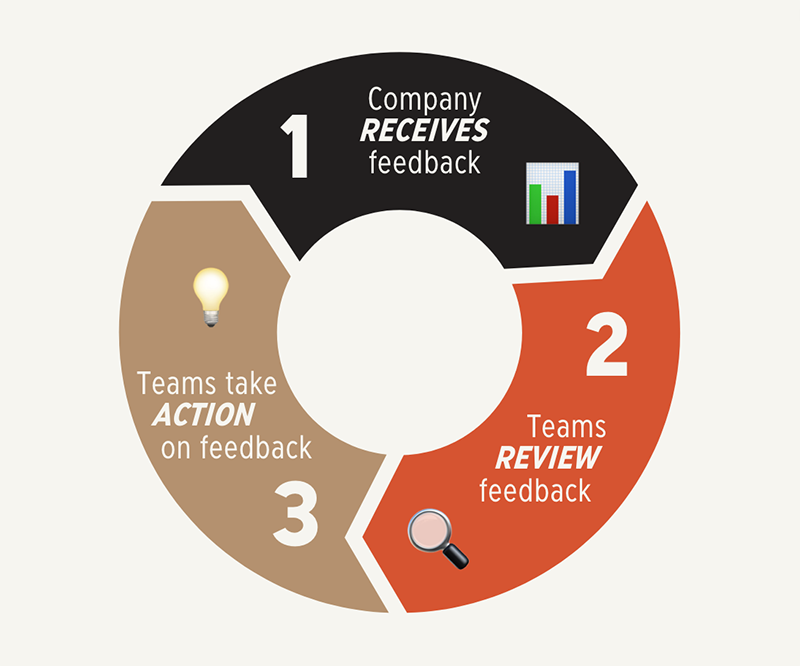
Our example company Pure Spa has noticed a trend among its younger customers. They’ve noticed that customers in the 20-something age bracket enjoy coming to the spa but only come for treatments sporadically, such as on their birthday. They wonder why this is and how they can better serve this segment of clientele. They wonder, “Are we doing something wrong?”
The first step is to engage the customer for feedback. This can be done simply by including a customer survey and feedback form during strategic parts of the customer experience.
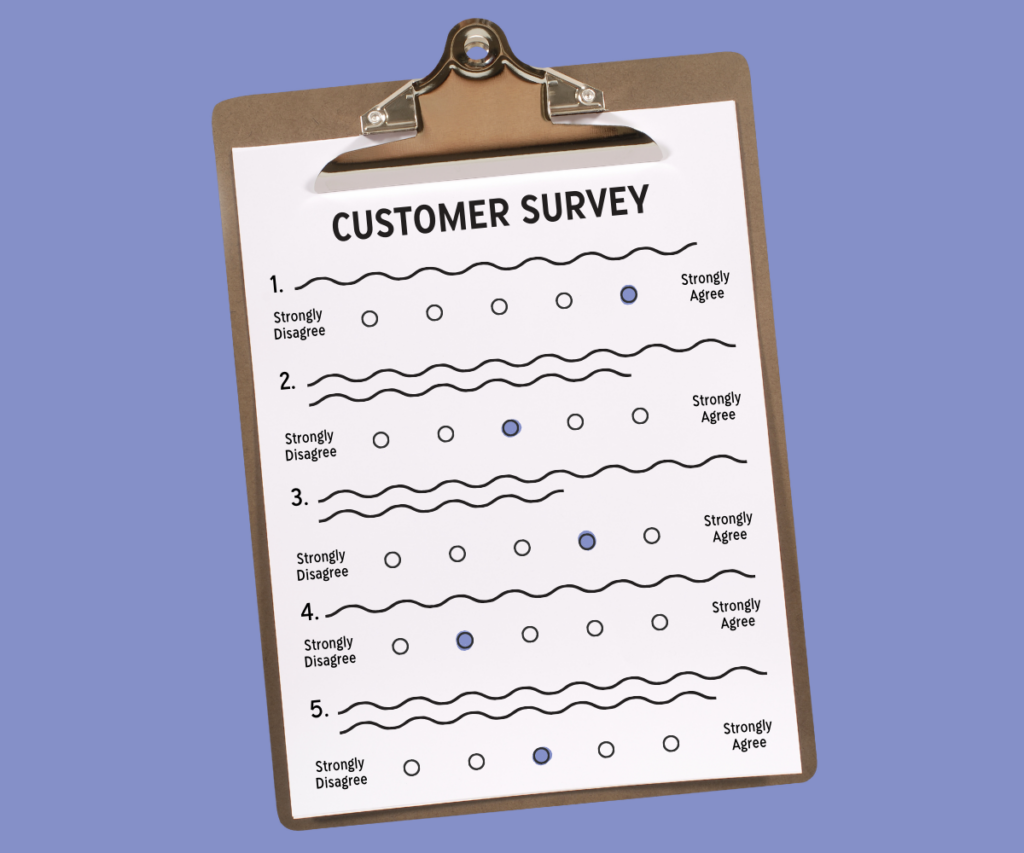
Pure Spa introduces a short survey form when the customer checks-out. The same survey is delivered in a ‘thank you’ email sent the day after their massage treatment.
The next step in the customer feedback loop is review customer feedback. Sit down with key members of your team and review their responses. Look for trends in the data that indicate a common area of contention.
Through their survey, Pure Spa discovers that 20-something customers are well aware of the benefits of regular spa treatments and they desire to partake in spa service offerings more regularly. But being new to the economic workforce, their spending power just doesn’t align with the cost of getting regular treatments.
The third step is to act on customer feedback. Brainstorm ways your company can solve this issue.
Sit down with the team and strategize solutions. Once a solution is discovered, introduce it as an ammendment to your regular line up of offerings.
In Spa NAME’s case, they decided to offer a monthly day spa rate that lets customers use their plunge pool, saunas, and other amenities without needing to book a massage treatment. They even put out rollers to let customers partake in a self massage. They found this allows customers on a budget to still engage in wellness activities and the spa in turn gains a new set of loyal, younger customers.
Remember, a customer feedback loop is circular. It doesn’t end when you implement the new solution.
Continue to get feedback from customers on the solution delivered. In the case of Nisolo, they continue the loop by asking for direct feedback from customers on their website.
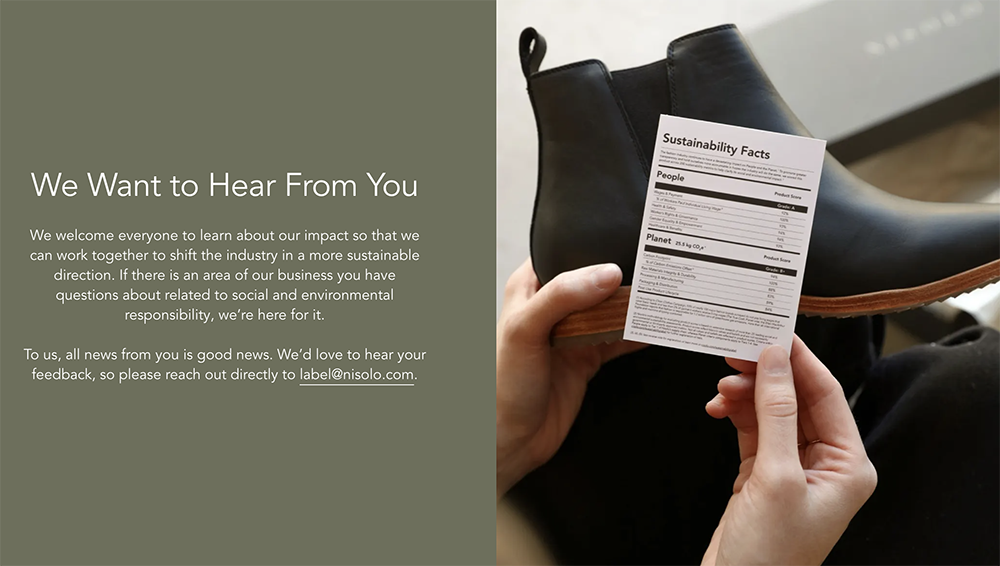
The more engaged you are with your customers and the more feedback, the more your customer experience and offerings will improve.
***
Wrap Up | Your Good Business Wrap Up
Let’s wrap this baby up.
You spent today with inspirational companies from across the globe and learned from their ways. Here are your takeaways.
- Governance: To create a close the loop system, you first have to know who your stakeholders are. Identify them all and brainstorm solutions that impact them all harmoniously.
- Workers: Promoting from within starts with company culture. Establish a company culture where promotions are a right, not a reward.
- Environment: 11th Hour Racing Team gifted us with The Toolbox to create a Sustainability Program.
- Community: A company volunteer day is a great way to connect with the community and remedy local problems.
- Customers: Use the customer feedback loop to listen to customers and improve your offering for an enhanced customer experience.
Share :
***
Key Takeaway
Any company — no matter the size or nature of its work — can develop creative solutions to big world problems and make a global impact.
Next Up
Join our weekly Backyard Tailgate, a newsletter to help brands live out their mission & lead with purpose.
Each Tuesday we visit your inbox to share what we’ve learned on our own impact journey, resources, tips & tricks and introduce you to some of our world changing friends. We keep it real. We keep it honest. But most importantly, we keep it actionable.
